Oracle Cloud Infrastructure 2023 Security Professional Questions and Answers
How can you increase the expiration of a pre-authenticated request (PAR) associated with a bucket? (Choose the best Answer.)
What does the following identity policy do?
Allow group my-group to use fn-invocation in compartment ABC where target.function.id = ‘
Which OCI services can encrypt all data-at-rest? Select TWO correct answers
Which type of file system does file storage use?
An automobile company needs to configure Bastion Managed SSH session to a compute
instance in a private subnet. What are the TWO prerequisites to configure successfully?
Which three Oracle Cloud Infrastructure (OCI) services are covered by Cloud Guard? (Choose three.)
A company needs to have somebuckets as public in the compartment. You want Cloud Guard to ignore the problem associated with public bucket. Select TWO correct answers
Which storage type is most effective when you want to move some unstructured data, consisting of images and videos, to cloud storage?
As a security administrator, you found out that there are users outside your co network who are accessing OCI Object Storage Bucket. How can you prevent these users from accessing OCI resources in corporate network?
Which type of software do you use to centrally distributeand monitor the patch level of systems throughout the enterprise?
Which solution enables you to privately connect two Virtual Cloud Networks (VCNS) across different Oracle Cloud Infrastructure (OCI) regions without routing traffic over the public Internet? (Choose the best Answer.)
As a security architect, how can you preventunwanted bots while desirable bots are allowed to enter?
An e-commerce company needs to authenticate with third-party API that don't support
OCI's signature-based authentication.
What can be the solution for the above scenario?
With regard to vulnerability and cloud penetration testing, which rules of engagement apply? Select TWO correct answers.
A company plans to use Oracle Cloud services for their production and development environments, but they have different security requirements. Their security policy forbids development environment users from having access to the production environment and requires separate administrators to manage each environment. The company has only one tenancy in Oracle Cloud. How can they ensure that their security requirements are met in Oracle Cloud? (Choose the best Answer.)
Which type of FastConnect supports configuring Oracle Cloud Infrastructure (OCI) Site-to-Site VPN for encryption? (Choose the best Answer.)
How can you limit access to an Oracle Cloud Infrastructure (OCI) Object Storage bucket to only the users Hark for within the corporate network? (Choose the best Answer.)
You are using a custom application with third-party APIs to manage application and data hosted in an Oracle Cloud Infrastructure (OCI) tenancy. Although your third-party APIs do not support OCI's signature-based authentication, you want them to communicate with OCI resources Which authentication option should you use to ensure this? (Choose the best Answer.)
What is the use case for Oracle Cloud Infrastructure (OCI) Logging Analytics service? (Choose the best Answer.)
Your company has implemented a new VPN connection policy, three months after you connected your on-premises network to Oracle Cloud Infrastructure (OCI). Your chief security officer has instructed you to edit the IPSec connection and replace the shared secrets with the new ones that he has provided. Where do you edit the shared secrets? (Choose the best Answer.)
Which of these protects customer data at rest and in transit in a way that allows customers to meet their security and compliance requirements forcryptographic algorithms and key management?
Hardware Security Modules (HSMs) in Oracle Key Management meet which Federal In-formation Processing Standards (FIPS) standard security certification that requires HSMs to be tamper-resistant and authentication to be identity-based? (Choose the best Answer.)
You are a security administrator for your company's Oracle Cloud Infrastructure (OCI) tenancy. Your storage administrator tells you he or she cannot associate an encryption key from OCI Voult to an Object Storage bucket in the new compartment. What is the reason? (Choose the best Answer.)
Which are the two responsibilities of Oracle when you move your IT infrastructure to Oracle Cloud Infrastructure (OCI)?
you are part of security operation of an organization with thousand of your users accessing Oracle cloud infrastructure it was reported that an unknown user action was executedresulting in configuration error you are tasked to quickly identify the details of all users who were active in the last six hours also with any rest API call that were executed. Which oci feature should you use?
Challenge 4 - Task 4 of 6
Configure Web Application Firewall to Protect Web Server Against XSS Attack
Scenario
You have to protect web applications hosted on OCI from cross-site scripting (XSS) attacks. You can use the OCI Web Application Firewall (WAF) capabilities to create rules that compare against incoming requests to determine if the request contains an XSS attack payload. If a request is determined to be an attack, WAF should return the HTTP Service Unavailable (503) error.
To ensure that the configured WAF blocks the XSS attack, run the following script: /index.html? ) To complete this deployment, you have to perform the following tasks in the environment provisioned for you: Note: You are provided with access to an OCI Tenancy, an assigned compartment, and OCI credentials. Throughout your exam, ensure to use the assigned Compartment 99233424-C01 and Region us-ashburn-1. Complete the following task in the provisioned OCI environment: Create a WAF policy with the name IAD-SP-PBT-WAF-01_99233424-lab.user01 Eg: IAD-SP-PBT-WAF-01_99232403-lab.user02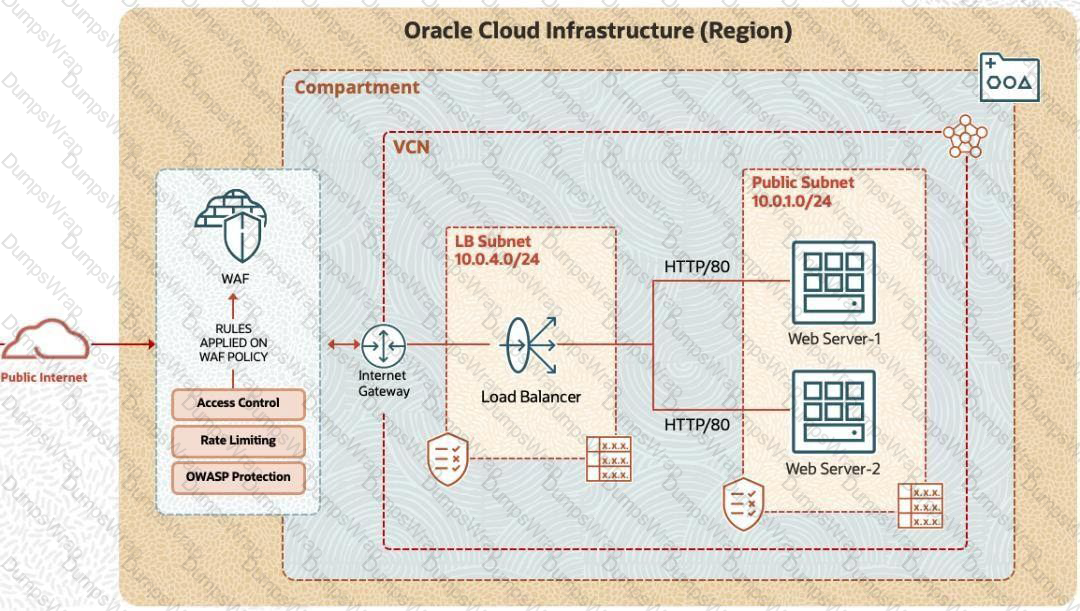
Challenge 4 - Task 3 of 6
Configure Web Application Firewall to Protect Web Server Against XSS Attack
Scenario
You have to protect web applications hosted on OCI from cross-site scripting (XSS) attacks. You can use the OCI Web Application Firewall (WAF) capabilities to create rules that compare against incoming requests to determine if the request contains an XSS attack payload. If a request is determined to be an attack, WAF should return the HTTP Service Unavailable (503) error.
To ensure that the configured WAF blocks the XSS attack, run the following script: /index.html? ) To complete this deployment, you have to perform the following tasks in the environment provisioned for you: Note: You are provided with access to an OCI Tenancy, an assigned compartment, and OCI credentials. Throughout your exam, ensure to use the assigned Compartment 99233424-C01 and Region us-ashburn-1. Complete the following task in the provisioned OCI environment: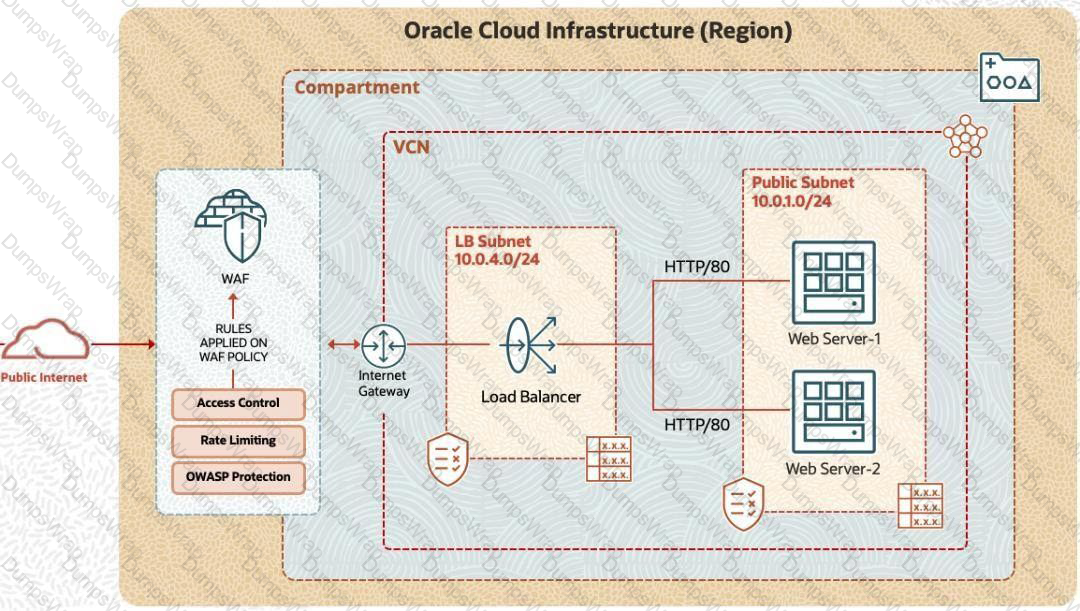
Challenge 3 - Task 4 of 4
Set Up a Bastion Host to Access the Compute Instance in a Private Subnet Scenario
A compute instance is provisioned in a private subnet that is not accessible through the Internet. To access the compute instance resource in a private subnet, you must provide a time-bound SSH session without deploying and maintaining a public subnet and a jump server, which eliminates the hassle and potential attack surface from remote access.
To complete this deployment, you have to perform the following tasks in the environment provisioned for you:
• Configure a Virtual Cloud Network (VCN) and a Private Subnet.
• Provision a Compute Instance in the private subnet and enable Bastion Plugin.
• Create a Bastion and Bastion session.
• Connect to a compute instance using Managed SSH session.
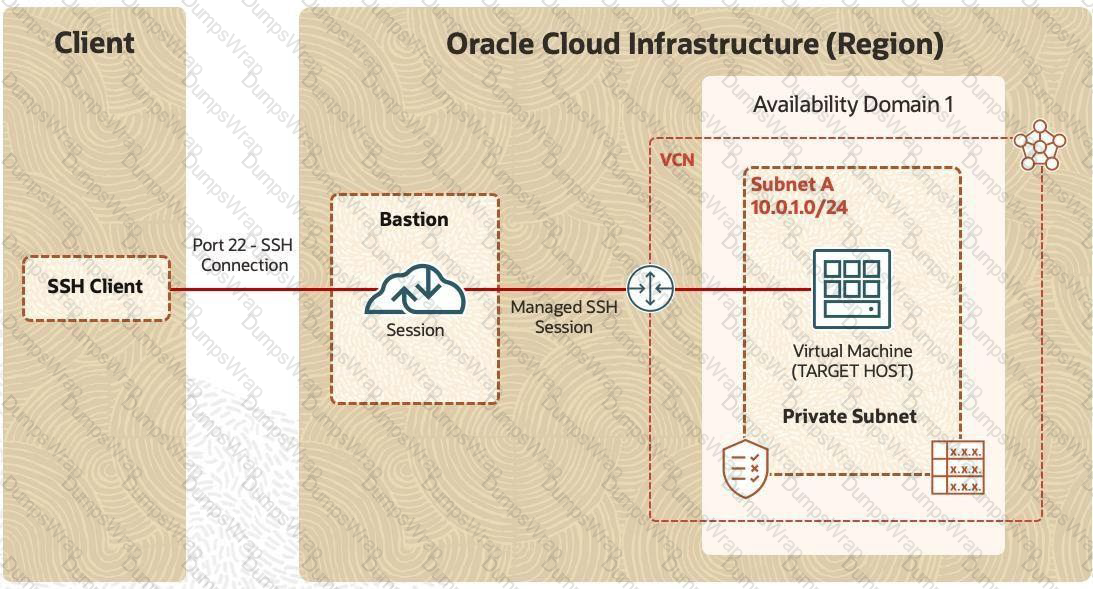
Note: You are provided with access to an OCI Tenancy, an assigned compartment, and OCI credentials. Throughout your exam, ensure to use the assigned Compartment 99233424-C01 and Region us-ashburn-1
Complete the following tasks in the provisioned OCI environment:
Connect to a compute instance using a Managed SSH Bastion session from your local machine terminal or Cloud shell.
Challenge 1 - Task 1 of 5
Authorize OCI Resources to Retrieve the Secret from the Vault
Scenario:
You are working on a Python program running on a compute instance that needs to access an external service. To access the external service, the program needs credentials (password). Given that it is not a best security practice, you decide not to hard code the credential in the program. Instead, you store the password (secret) in a vault using the OCI Vault service. The requirement now is to authorize the compute instance so that the Python program can retrieve the password (secret) by making an API call to the OCI Vault.
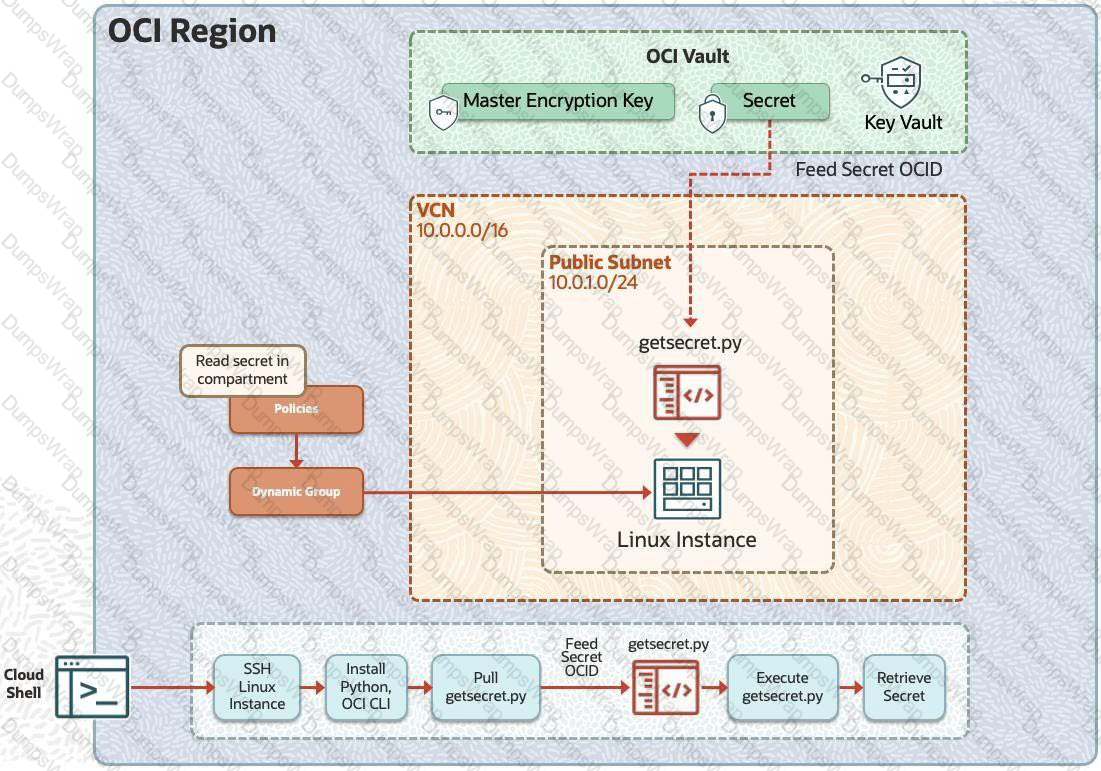
Preconfigured:
To complete this requirement, you are provided with:
- An OCI Vault to store the secret required by the program, which is created in the root compartment as PBT_Vault_SP.
- An instance principal IAM service, which enables instances to be authorized actors (principals) that can retrieve the secret from the OCI Vault.
- A dynamic group named PBT_Dynamic_Group_SP with permissions to access the OCI Vault. This dynamic group includes all of the instances in your compartment.
- Access to Cloud Shell.
- Permissions to perform only the tasks within the challenge.
Note: You are provided with access to an OCI Tenancy, an assigned compartment, and OCI credentials. Throughout your exam, ensure to use the assigned Compartment 99234021-C01 and Region us-ashburn-1.
Complete the following tasks in the OCI environment provisioned:
- Create Master Encryption Key with the name my_pbt_msk with 256 bits shape.
- Create a Secret with the name my-pbt-secret_99234021-lab.user01 and secret content.
For example: If your user name is 99346163-lab.user02, then the secret should be named as my-pbt-secret_99346163-lab.user02.
Challenge 3 - Task 1 of 4
Set Up a Bastion Host to Access the Compute Instance in a Private Subnet Scenario
A compute instance is provisioned in a private subnet that is not accessible through the Internet. To access the compute instance resource in a private subnet, you must provide a time-bound SSH session without deploying and maintaining a public subnet and a jump server, which eliminates the hassle and potential attack surface from remote access.
To complete this deployment, you have to perform the following tasks in the environment provisioned for you:
• Configure a Virtual Cloud Network (VCN) and a Private Subnet.
• Provision a Compute Instance in the private subnet and enable Bastion Plugin.
• Create a Bastion and Bastion session.
• Connect to a compute instance using Managed SSH session.
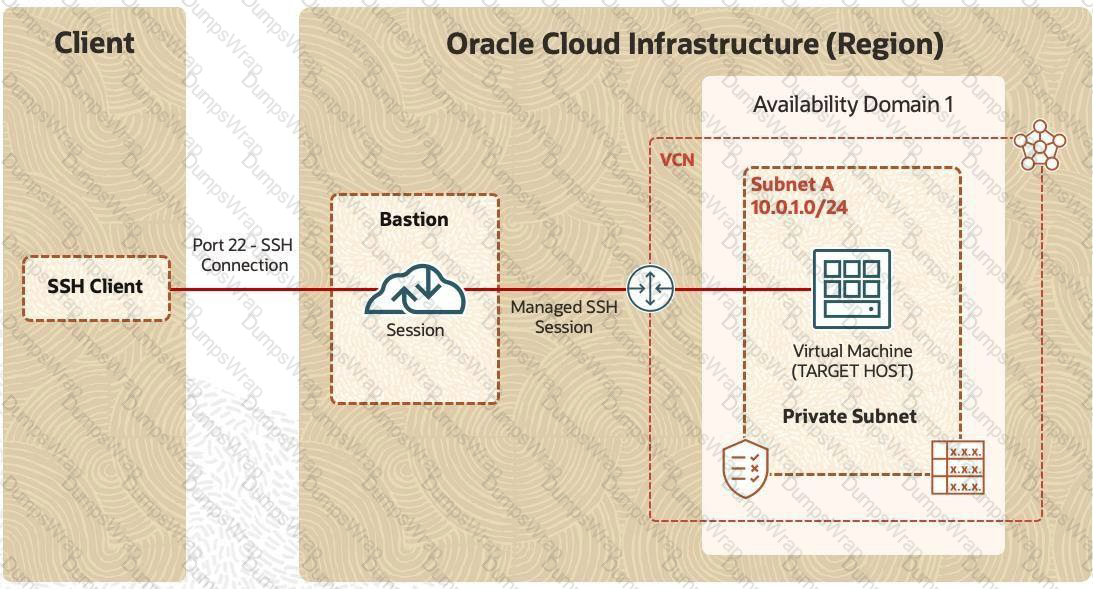
Note: You are provided with access to an OCI Tenancy, an assigned compartment, and OCI credentials. Throughout your exam, ensure to use the assigned Compartment 99233424-C01 and Region us-ashburn-1
Complete the following tasks in the provisioned OCI environment:
- Create a Virtual Cloud Network (VCN) with the name PBT-BAS-VCN-01
- Create a Private Subnet with the name PBT-BAS-SNET-01
- Create a Service Gateway with the name PBT-BAS-SG-01, using the service "All IAD Services in Oracle Services Network"
- Add Route Rules for Service Gateway
Challenge 2
Least-Privileged Model Enforcement Leveraging Custom Security Zones
Scenario
In deploying a new application, a cloud customer needs to reflect different security postures. If a security zone is enabled with the Maximum Security Zone recipe, the customer will be unable to create or update a resource in the Security Zone if the action violates the attached Maximum Security Zone policy.
As an application requirement, the customer requires a compute instance in the public subnet. You, therefore, need to configure Custom Security Zones that allow the creation of compute instances in the public subnet.
To complete this deployment, you have to perform the following tasks in the environment provisioned for you:
• Create a Custom Security Zone recipe to allow compute instances in the public subnet.
• Create a Security Zone using the Custom Security Zone recipe.
• Configure a Virtual Cloud Network (VCN) and Public Subnet.
• Provision a Compute Instance in the public subnet.
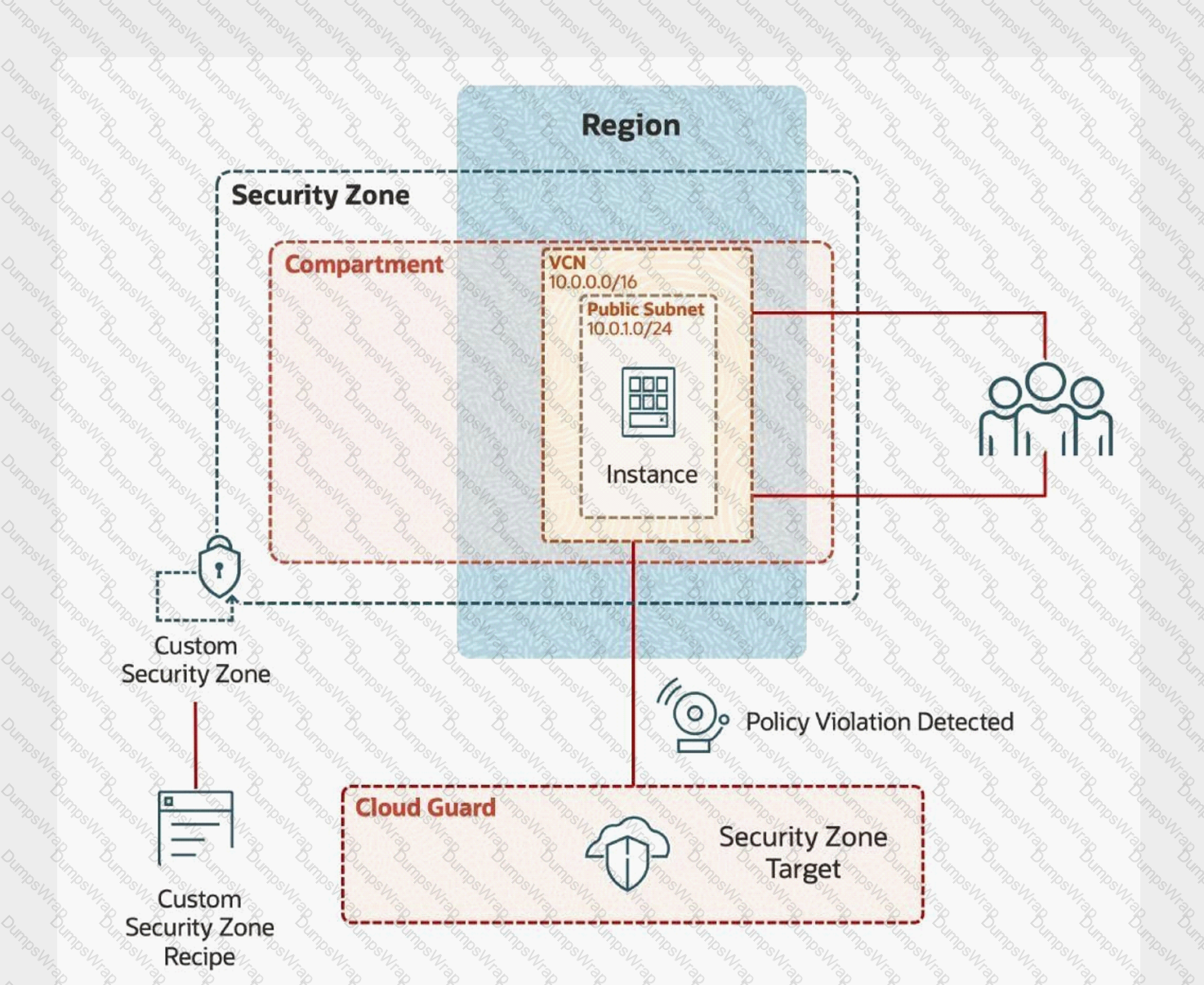
Note: You are provided with access to an OCI Tenancy, an assigned compartment, and OCI credentials. Throughout your exam, ensure to use the assigned Compartment 99234021-C01 and Region us-ashburn-1
Complete the following tasks in the provisioned OCI environment:
- Create a Custom Recipe with the name
- Create a Security Zone with the name
- Create a VCN with the name IAD-SP-PBT-VCN-01
- Create a Public Subnet with the name IAD-SP-PBT-PUBSNET-01
- Create a Compute Instance with the name IAD-SP-PBT-1-VM-01, using the "Oracle Linux 8" image and "VM.Standard2.1" as shape
Challenge 1 - Task 5 of 5
Authorize OCI Resources to Retrieve the Secret from the Vault
Scenario
You are working on a Python program running on a compute instance that needs to access an external service. To access the external service, the program needs credentials (password). Given that it is not a best security practice, you decide not to hard code the credential in the program. Instead, you store the password (secret) in a vault using the OCI Vault service. The requirement now is to authorize the compute instance so that the Python program can retrieve the password (secret) by making an API call to the OCI Vault.
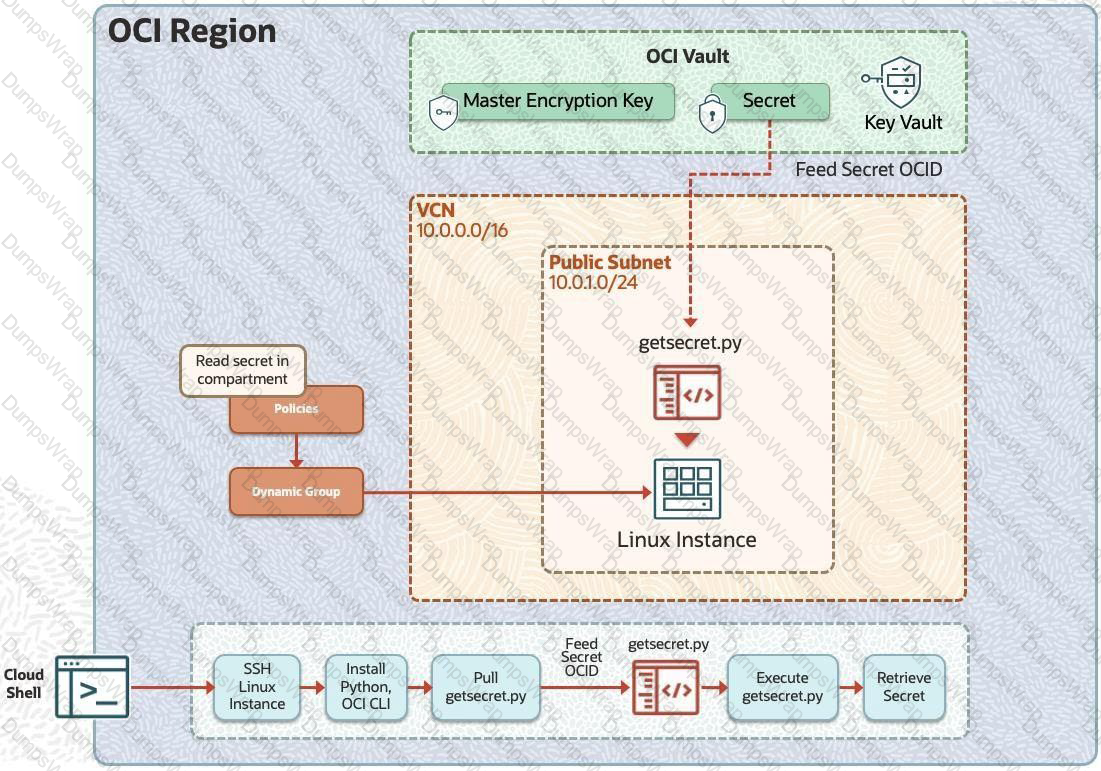
Preconfigured
To complete this requirement, you are provided with:
- An OCI Vault to store the secret required by the program, which is created in the root compartment as PBT_Vault_SP.
- An instance principal IAM service, which enables instances to be authorized actors (principals) that can retrieve the secret from the OCI Vault.
- A dynamic group named PBT_Dynamic_Group_SP with permissions to access the OCI Vault. This dynamic group includes all of the instances in your compartment.
- Access to Cloud Shell.
- Permissions to perform only the tasks within the challenge.
Note: You are provided with access to an OCI Tenancy, an assigned compartment, and OCI credentials. Throughout your exam, ensure to use the assigned Compartment 99234021-C01 and Region us-ashburn-1.
Challenge 4 - Task 6 of 6
Configure Web Application Firewall to Protect Web Server Against XSS Attack
Scenario
You have to protect web applications hosted on OCI from cross-site scripting (XSS) attacks. You can use the OCI Web Application Firewall (WAF) capabilities to create rules that compare against incoming requests to determine if the request contains an XSS attack payload. If a request is determined to be an attack, WAF should return the HTTP Service Unavailable (503) error.
To ensure that the configured WAF blocks the XSS attack, run the following script: /index.html? ) To complete this deployment, you have to perform the following tasks in the environment provisioned for you: Note: You are provided with access to an OCI Tenancy, an assigned compartment, and OCI credentials. Throughout your exam, ensure to use the assigned Compartment 99233424-C01 and Region us-ashburn-1. Complete the following task in the provisioned OCI environment: You will connect to the web server and append an XSS script. The protection rule will evaluate the requests and respond accordingly.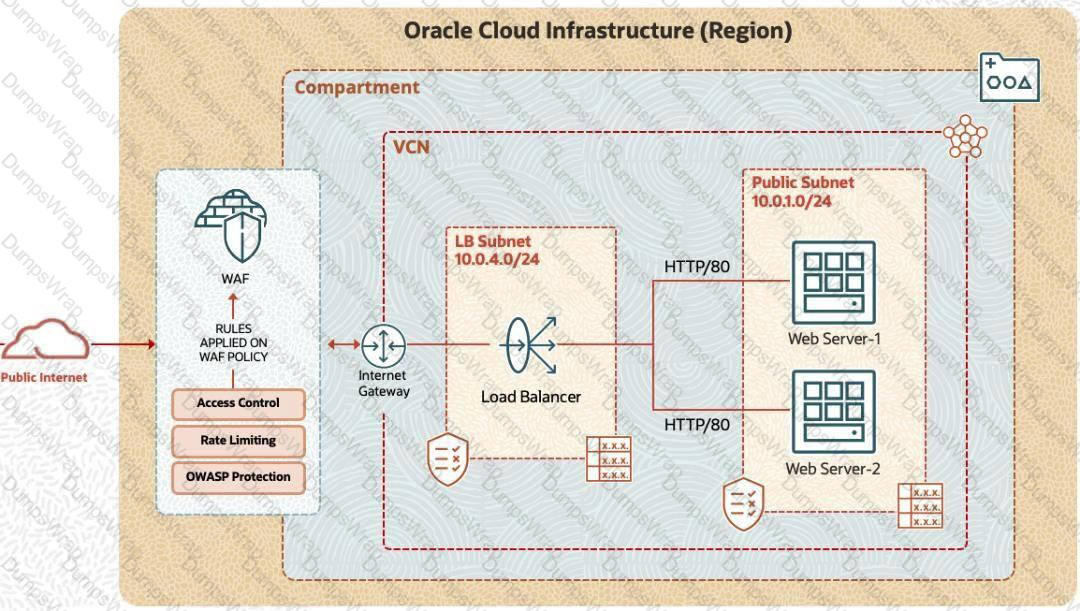
Challenge 1 - Task 2 of 5
Authorize OCI Resources to Retrieve the Secret from the Vault
Scenario
You are working on a Python program running on a compute instance that needs to access an external service. To access the external service, the program needs credentials (password). Given that it is not a good security practice, you decide not to hard code the credential in the program. Instead, you store the password (secret) in a vault using the OCI Vault service. The requirement now is to authorize the compute instance so that the Python program can retrieve the password (secret) by making an API call to the OCI Vault.
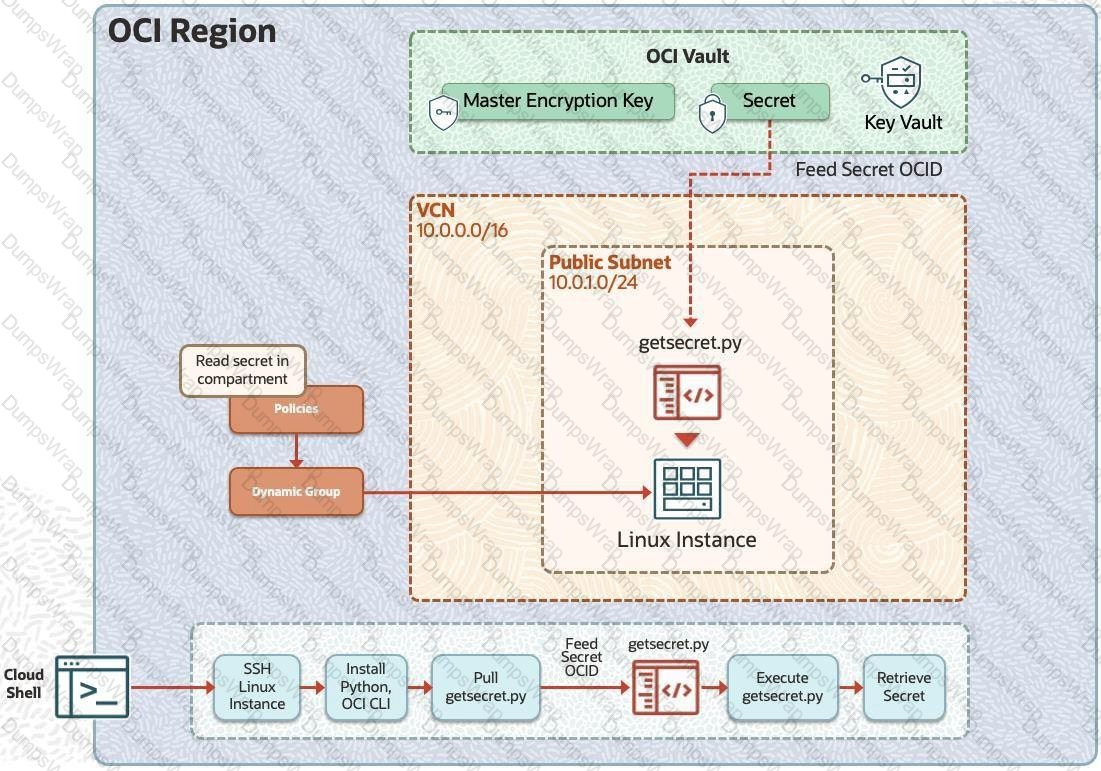
Preconfigured:
To complete this requirement, you are provided with:
- An OCI Vault to store the secret required by the program, which is created in the root compartment as PBT_Vault_SP.
- An instance principal IAM service, which enables instances to be authorized actors (principals) that can retrieve the secret from the OCI Vault.
- A dynamic group named PBT_Dynamic_Group_SP with permissions to access the OCI Vault. This dynamic group includes all of the instances in your compartment.
- Access to Cloud Shell.
- Permissions to perform only the tasks within the challenge.
Note: You are provided with access to an OCI Tenancy, an assigned compartment, and OCI credentials. Throughout your exam, ensure to use the assigned Compartment 99234021-C01 and Region us-ashburn-1.
Complete the following task:
In the field below, write the IAM policy, which allows a program running on a computer instance (principal instance) to retrieve a secret from the OCI Vault.
Challenge 4 - Task 1 of 6
Configure Web Application Firewall to Protect Web Server Against XSS Attack
Scenario
You have to protect web applications hosted on OCI from cross-site scripting (XSS) attacks. You can use the OCI Web Application Firewall (WAF) capabilities to create rules that compare against incoming requests to determine if the request contains an XSS attack payload. If a request is determined to be an attack, WAF should return the HTTP Service Unavailable (503) error.
To ensure that the configured WAF blocks the XSS attack, run the following script: /index.html? ) To complete this deployment, you have to perform the following tasks in the environment provisioned for you: Note: You are provided with access to an OCI Tenancy, an assigned compartment, and OCI credentials. Throughout your exam, ensure to use the assigned Compartment 99233424-C01 and Region us-ashburn-1. Complete the following task in the provisioned OCI environment: Create a VCN using wizard with the name IAD-WAF-PBT-VCN-01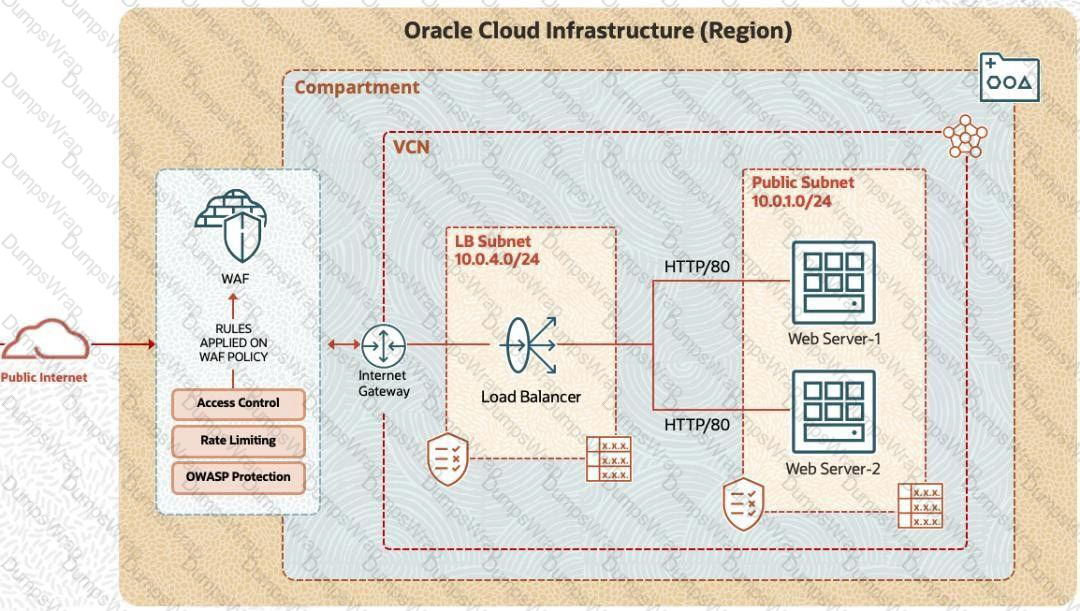
Challenge 4 - Task 5 of 6
Configure Web Application Firewall to Protect Web Server Against XSS Attack
Scenario
You have to protect web applications hosted on OCI from cross-site scripting (XSS) attacks. You can use the OCI Web Application Firewall (WAF) capabilities to create rules that compare against incoming requests to determine if the request contains an XSS attack payload. If a request is determined to be an attack, WAF should return the HTTP Service Unavailable (503) error.
To ensure that the configured WAF blocks the XSS attack, run the following script: /index.html? ) To complete this deployment, you have to perform the following tasks in the environment provisioned for you: Note: You are provided with access to an OCI Tenancy, an assigned compartment, and OCI credentials. Throughout your exam, ensure to use the assigned Compartment 99233424-C01 and Region us-ashburn-1. Complete the following task in the provisioned OCI environment: 1. Create a Protection Rule with name WAF-PBT-XSS-Protection against XSS attack. for protecting web server 2. Create a New Rule Action with name WAF-PBT-XSS-Action where http response code will be 503 (Service Unavailable).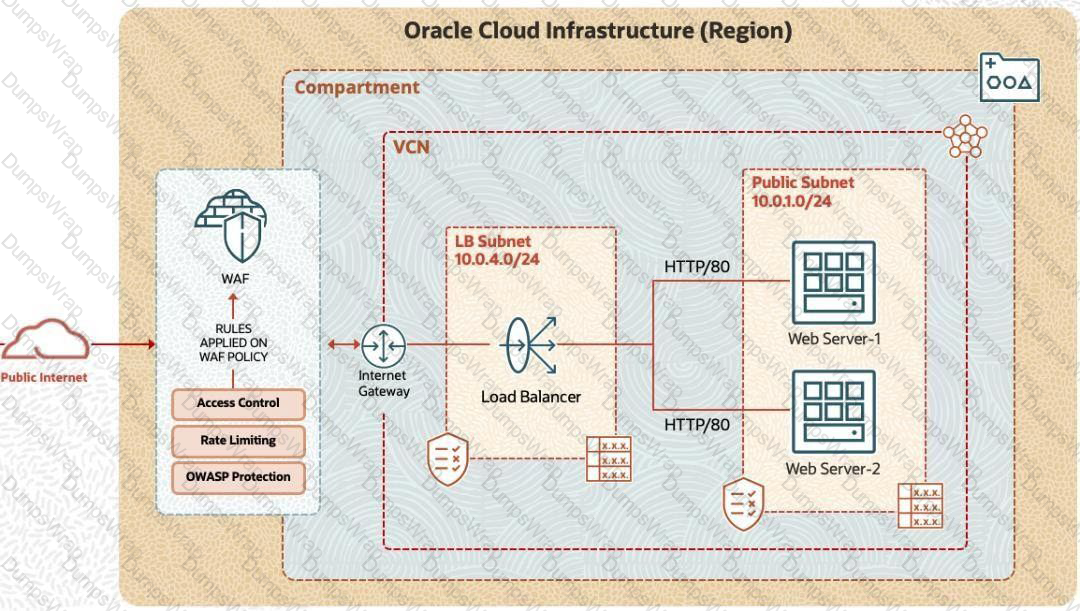
Challenge 1 - Task 3 of 5
Authorize OCI Resources to Retrieve the Secret from the Vault
Scenario
You are working on a Python program running on a compute instance that needs to access an external service. To access the external service, the program needs credentials (password). Given that it is not a best security practice, you decide not to hard code the credential in the program. Instead, you store the password (secret) in a vault using the OCI Vault service. The requirement now is to authorize the compute instance so that the Python program can retrieve the password (secret) by making an API call to the OCI Vault.
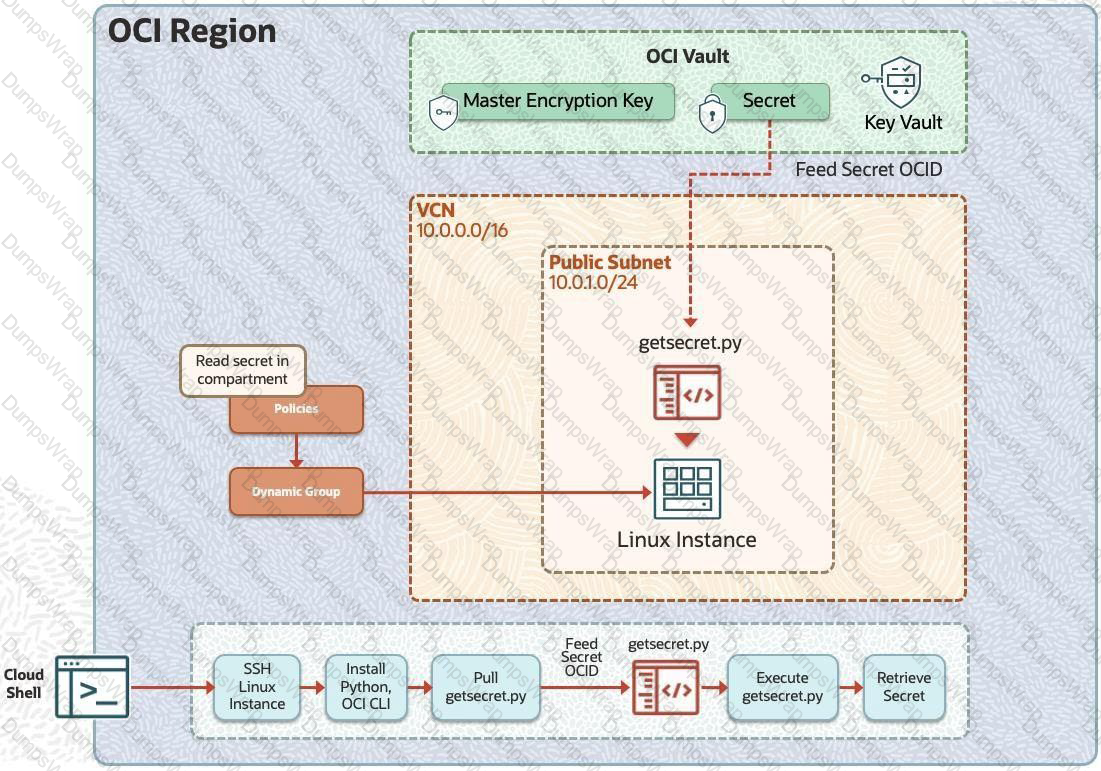
Preconfigured
To complete this requirement, you are provided with:
- An OCI Vault to store the secret required by the program, which is created in the root compartment as PBT_Vault_SP.
- An instance principal IAM service, which enables instances to be authorized actors (principals) that can retrieve the secret from the OCI Vault.
- A dynamic group named PBT_Dynamic_Group_SP with permissions to access the OCI Vault. This dynamic group includes all of the instances in your compartment.
- Access to Cloud Shell.
- Permissions to perform only the tasks within the challenge.
Note: You are provided with access to an OCI Tenancy, an assigned compartment, and OCI credentials. Throughout your exam, ensure to use the assigned Compartment 99234021-C01 and Region us-ashburn-1.
Complete the following task in the OCI environment provisioned:
Create a new VCN with the name PBT_SECRET_VCN01 and public subnet within your assigned compartment.
Challenge 4 - Task 2 of 6
Configure Web Application Firewall to Protect Web Server Against XSS Attack
Scenario
You have to protect web applications hosted on OCI from cross-site scripting (XSS) attacks. You can use the OCI Web Application Firewall (WAF) capabilities to create rules that compare against incoming requests to determine if the request contains an XSS attack payload. If a request is determined to be an attack, WAF should return the HTTP Service Unavailable (503) error.
To ensure that the configured WAF blocks the XSS attack, run the following script: /index.html? ) To complete this deployment, you have to perform the following tasks in the environment provisioned for you: Note: You are provided with access to an OCI Tenancy, an assigned compartment, and OCI credentials. Throughout your exam, ensure to use the assigned Compartment 99233424-C01 and Region us-ashburn-1. Complete the following task in the provisioned OCI environment: b. Enable Apache and start Apache server: c. Create a firewall rule to enable HTTP connection through port 80 and reload the firewall: d. Create an index file for your web server: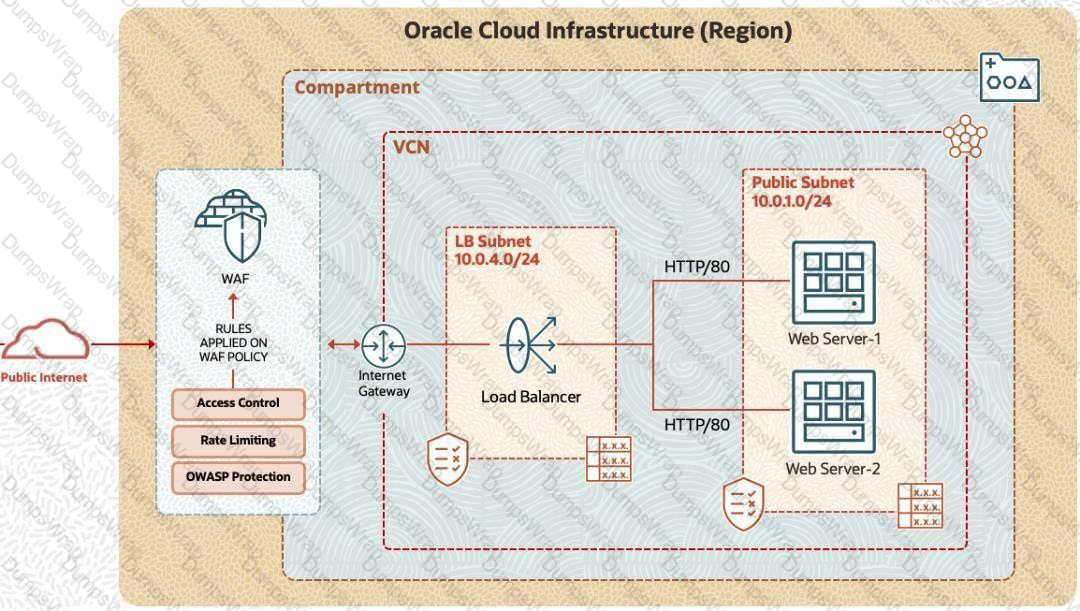
Challenge 1 - Task 4 of 5
Authorize OCI Resources to Retrieve the Secret from the Vault
Scenario
You are working on a Python program running on a compute instance that needs to access an external service. To access the external service, the program needs credentials (password). Given that it is not a best security practice, you decide not to hard code the credential in the program. Instead, you store the password (secret) in a vault using the OCI Vault service. The requirement now is to authorize the compute instance so that the Python program can retrieve the password (secret) by making an API call to the OCI Vault.
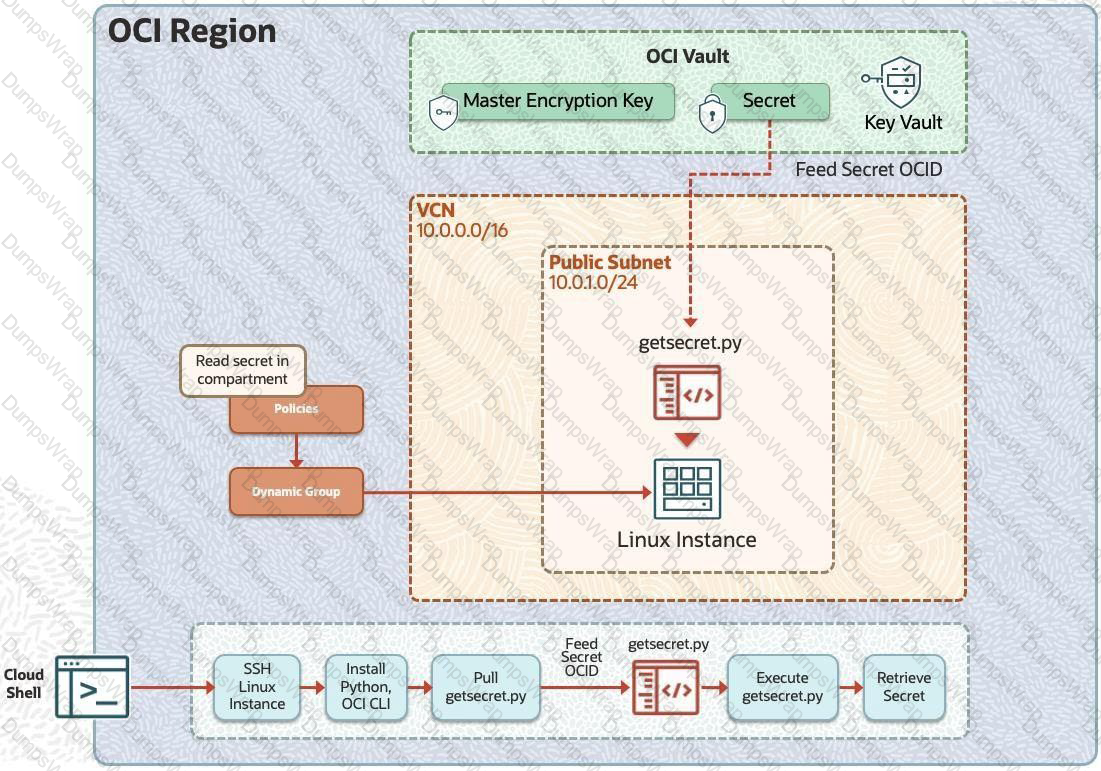
Preconfigured
To complete this requirement, you are provided with:
- An OCI Vault to store the secret required by the program, which is created in the root compartment as PBT_Vault_SP.
- An instance principal IAM service, which enables instances to be authorized actors (principals) that can retrieve the secret from the OCI Vault.
- A dynamic group named PBT_Dynamic_Group_SP with permissions to access the OCI Vault. This dynamic group includes all of the instances in your compartment.
- Access to Cloud Shell.
- Permissions to perform only the tasks within the challenge.
Note: You are provided with access to an OCI Tenancy, an assigned compartment, and OCI credentials. Throughout your exam, ensure to use the assigned Compartment 99234021-C01 and Region us-ashburn-1.
Complete the following tasks in the OCI environment provisioned:
- Create a Linux Instance with the name [Provide Name Here] within the compartment.
Provide your own public key to SSH the instance.
Challenge 3 - Task 2 of 4
Set Up a Bastion Host to Access the Compute Instance in a Private Subnet Scenario
A compute instance is provisioned in a private subnet that is not accessible through the Internet. To access the compute instance resource in a private subnet, you must provide a time-bound SSH session without deploying and maintaining a public subnet and a jump server, which eliminates the hassle and potential attack surface from remote access.
To complete this deployment, you have to perform the following tasks in the environment provisioned for you:
• Configure a Virtual Cloud Network (VCN) and a Private Subnet.
• Provision a Compute Instance in the private subnet and enable Bastion Plugin.
• Create a Bastion and Bastion session.
• Connect to a compute instance using Managed SSH session.
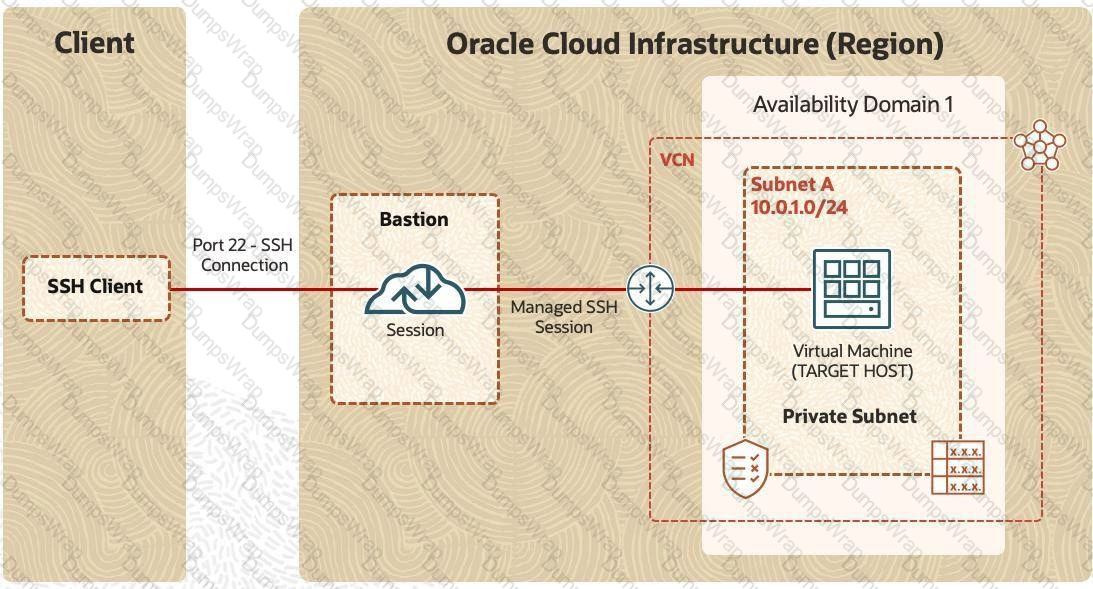
Note: You are provided with access to an OCI Tenancy, an assigned compartment, and OCI credentials. Throughout your exam, ensure to use the assigned Compartment 99233424-C01 and Region us-ashburn-1
Complete the following tasks in the provisioned OCI environment:
Create a Compute Instance with the name PBT-BAS-VM-01, using the "Oracle Linux 8" image and shape "VM.Standard2.1", without SSH key and enable Bastion plugin.
Challenge 3 - Task 3 of 4
Set Up a Bastion Host to Access the Compute Instance in a Private Subnet Scenario
A compute instance is provisioned in a private subnet that is not accessible through the Internet. To access the compute instance resource in a private subnet, you must provide a time-bound SSH session without deploying and maintaining a public subnet and a jump server, which eliminates the hassle and potential attack surface from remote access.
To complete this deployment, you have to perform the following tasks in the environment provisioned for you:
• Configure a Virtual Cloud Network (VCN) and a Private Subnet.
• Provision a Compute Instance in the private subnet and enable Bastion Plugin.
• Create a Bastion and Bastion session.
• Connect to a compute instance using Managed SSH session.
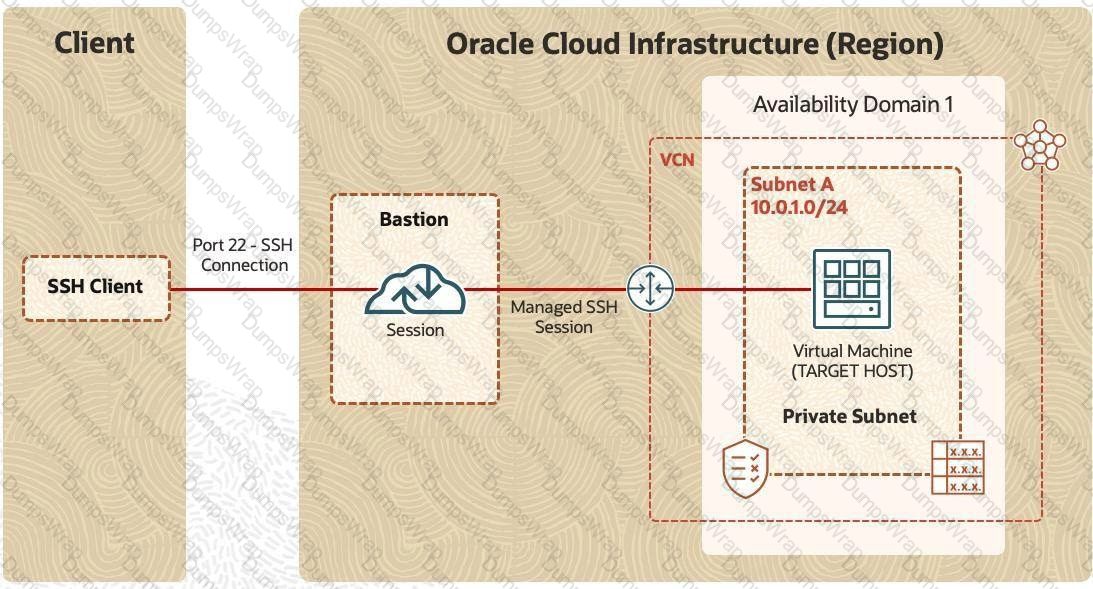
Note: You are provided with access to an OCI Tenancy, an assigned compartment, and OCI credentials. Throughout your exam, ensure to use the assigned Compartment 99233424-C01 and Region us-ashburn-1
Complete the following tasks in the provisioned OCI environment:
1. Create a Bastion with the name SPPBTBASTION99233424-lab.user01
[Eliminate Specical Characters] Eg:SPPBTBASTION992831403labuser13
2. Create a Session with the name PBT-1-Session-01, for compute instance in private subnet, with default username as "opc"

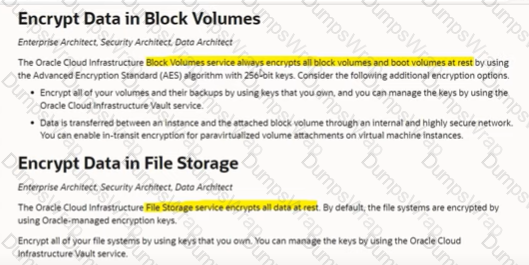 Graphical user interface, text, application, email Description automatically generated
Graphical user interface, text, application, email Description automatically generated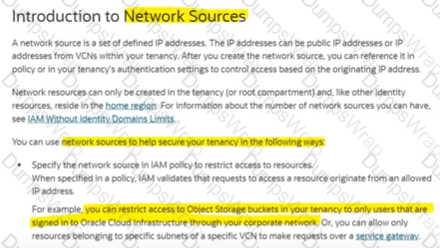 Graphical user interface, text, application Description automatically generated
Graphical user interface, text, application Description automatically generated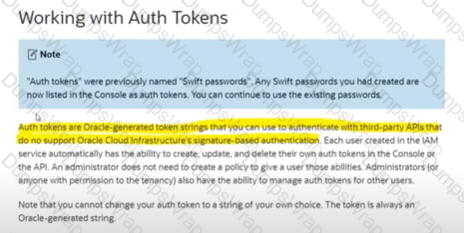 Graphical user interface, text, application, email Description automatically generated
Graphical user interface, text, application, email Description automatically generated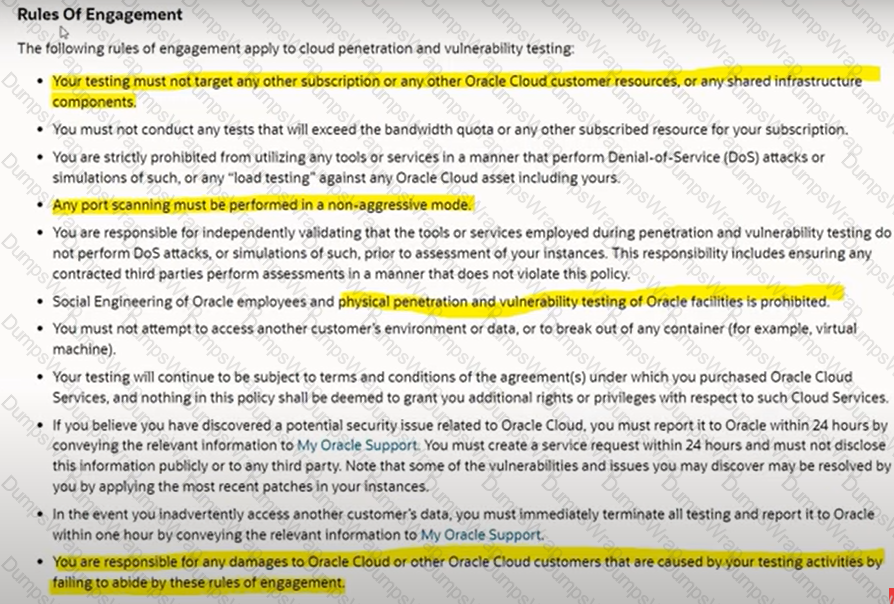 Graphical user interface, text, application Description automatically generated
Graphical user interface, text, application Description automatically generated